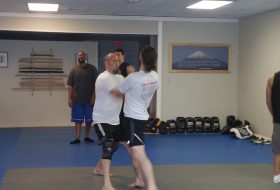We can agree that personal protection can be chaotic for anyone involved. The more you participate, the more complex it can seem. Yet, the majority of truly personal protection oriented solutions are not complex at all.
In fact, they are often the simplest solutions that offer up the majority of answers to the complexity of personal protection. From what I can see, this is where most martial arts fail in regards to realistic personal protection.
For many, it isn’t that they aren’t competent athletes, or that they just aren’t good enough to protect themselves. It seems more to be true that most people, most martial arts, prefer to try to answer complexity with more complexity. And, the fact is, that can sometimes actually work.
But the problem with complex systems, complex ideas, and complex solutions is that more often than not, if there is any kind of variation in the problem it is trying to solve, or in the performance of the solution, the whole “answer” breaks down.
To manage “complexity” as a problem it is not uncommon to hear people in self-defense teaching that gross-motor skills are the only thing that work. But before we can truly know if that is true, we must first identify what gross-motor skills means by definition.
According to the Psychology Dictionary, Gross Motor skills by definition are:
“…are the activities and skills using the large muscles to move our limbs and trunk. They control balance and posture and include waving arms, walking and running.”
Gross motor movements are used in activities like walking, running, and waving arms as discussed above but also include things like dribbling a basketball, climbing a tree, swinging a baseball bat or even a hammer. That means that even things like grip changes or how hard or how fast you swing or throw or shoot are all considered gross motor.
Gross motor movements sound like Frankenstein walking but in fact they are actually pretty complex in nature and require fluid adjustment for much of their use and even training. Just think about how many times a basketball player practices shooting a shot.
Yes, the gross motor skills are fairly simple, but to become an expert at shooting a basketball requires a lot of practice to understand power, balance, thrust, pressure distribution, etc.
Fine Motor skills are definitely not used much in personal protection or self-defense, but they aren’t used much in martial arts either. Fine Motor skills involve the picking up of very fine and small objects, or writing, and drawing. Basically they are focused on finger to hand and eye coordination. And that’s about it….
As you can see, the real problem is not really gross motor or fine motor skills. It’s complexity. Complex solutions degrade much easier and more completely than simple solutions, but the argument of gross motor and fine motor is not accurate. I’ve never once drawn or painted or written something while practicing a traditional martial arts application.
Just something to think about….
Sincerely,
Guru Stark
A small excerpt from Guerrilla Silat Personal Protection book currently in the works.
Keep an eye out for it.



